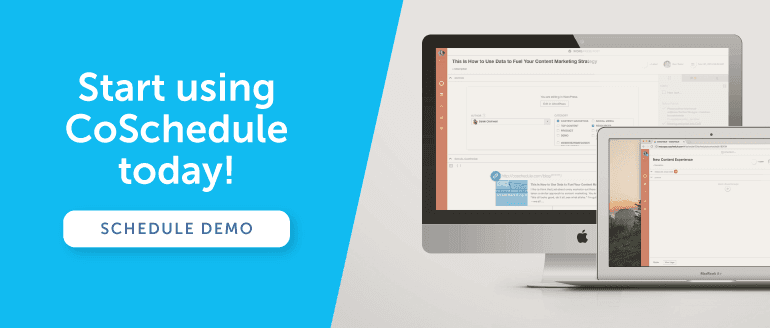How To Overcome Makeshift Marketing With New Marketing Superpowers
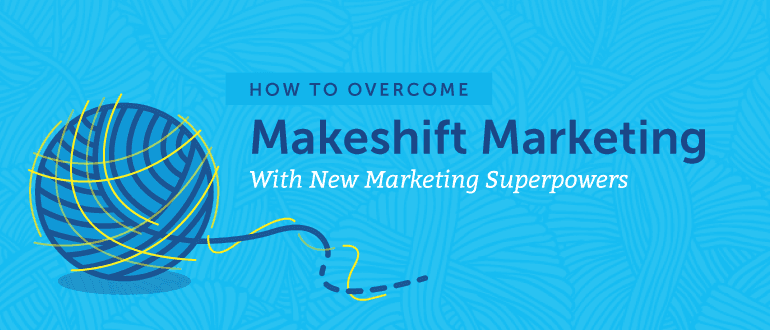 It’s hard to be productive when you don’t realize the forces working against you.
It’s even tougher when habits you viewed as assets are actually liabilities.
In modern marketing, this is the game we’re all playing. And there’s a lot riding on us to get results.
When we fail, our companies don’t grow.
When we’re ineffective, our brand suffers.
Not to mention we’re unhappy with ourselves when we underperform.
The good news is these unseen forces actually have a face, a name, and are easy to spot once unveiled.
Better still, they have a single source we can outpace if we focus in the right place.
In this post, I will share with you:
It’s hard to be productive when you don’t realize the forces working against you.
It’s even tougher when habits you viewed as assets are actually liabilities.
In modern marketing, this is the game we’re all playing. And there’s a lot riding on us to get results.
When we fail, our companies don’t grow.
When we’re ineffective, our brand suffers.
Not to mention we’re unhappy with ourselves when we underperform.
The good news is these unseen forces actually have a face, a name, and are easy to spot once unveiled.
Better still, they have a single source we can outpace if we focus in the right place.
In this post, I will share with you:
- The most common cause of poor productivity in modern marketing,
- Exactly how it harms our personal and team results by 40% or more,
- And how to acquire the superpower you need to beat it.
How To Overcome Makeshift Marketing With New Marketing Superpowers via @CoSchedule
Click To TweetThe Many Faces Of Makeshift Marketing
In marketing, we need to move quickly. We need to launch campaigns with speed… Run effective ads the first time around... Publish content that produces results... And do this all to the tune of providing real business value. However, our overwhelming tide of tools and demands presses hard against our mission. The modern marketing stack makes staying organized hard. The reality is that today’s marketing landscape is flooded with single-function tools. You’ve got your planning tools, social stack, tools for content marketing, and then productivity tools to manage your team. Problem is, none of them play well together. This makes your life more difficult and actually costs you results. Around here, we call it Makeshift Marketing, and what we mean is many of the teams we talk to end up adopting a variety of tools just to get their work done… They’ll use one tool for social, and another for task management, and then before they know it they end up adding a spreadsheet to the mix to TRY and tie it all together…
How You’re Losing Productivity + Results
So let’s talk about why this actually costs us marketers so much. One of makeshift marketing’s worst effects is called context switching. It’s a way of describing the productivity tax of changing from one activity to another. Psychologically, it involves two stages: goal shifting and rule activation. Stage one is goal shifting, which is a function of choosing a new task to focus on. Stage two is rule activation, which means your brain is turning off the rules of the old task and turning on the rules for the new one. For example, let’s say you’re in a meeting about an upcoming marketing campaign. Your team is walking through the launch brief, everyone’s roles, and those all-important deadlines. However, while Fred is talking about the the key metrics you’ll be measuring, your phone buzzes with an email notification. Your habit of immediately responding nudges you to check it on the sly beneath the conference table. (C’mon, we’ve all done it. It’s NOT like you’re driving.) The email is from your boss, and it’s in reply to an email from her boss asking about the status of a project. The simple question she asked is: “Where are we at on this?” #ugh
Is she mad?
Does she think the delay is your fault, even though you’re waiting on another team?
You reply with: “Have it on my radar for today. Will follow up ASAP.”
Then quickly open your todo app and add that to your ever-growing list. You were going to do this later this afternoon anyways, but unfortunately she beat you to it.
This project is a killer. And you’re the only conduit of communication between your boss, external stakeholders, internal teams, and of course your own team.
Why?
Because there is no central version of truth for everyone to check and keep on the same page. But that’s another project for another day...
You lock your phone and you’re back to Fred.
However, not only did you miss a few details, you’re trying to catch up to the entire thrust of what he was saying to begin with.
In fact, you probably forgot all about Fred while reading this little email episode.
#ugh
Is she mad?
Does she think the delay is your fault, even though you’re waiting on another team?
You reply with: “Have it on my radar for today. Will follow up ASAP.”
Then quickly open your todo app and add that to your ever-growing list. You were going to do this later this afternoon anyways, but unfortunately she beat you to it.
This project is a killer. And you’re the only conduit of communication between your boss, external stakeholders, internal teams, and of course your own team.
Why?
Because there is no central version of truth for everyone to check and keep on the same page. But that’s another project for another day...
You lock your phone and you’re back to Fred.
However, not only did you miss a few details, you’re trying to catch up to the entire thrust of what he was saying to begin with.
In fact, you probably forgot all about Fred while reading this little email episode.
What Really Happened While Fred Was Talking
In this not-so-imaginary example, it wasn’t simple distraction that took place. When you turned your attention from the meeting to read your email, your mind entered goal-shift mode, expending energy to focus on a new task. While you thought you could listen to Fred and email at the same time, your biological limitations said differently — because multitasking is a myth. Next, upon reading and replying to the email, the next stage took place. It’s called new rule activation, meaning your brain crunched all of the parameters of your relationship with your boss, the project, and its multiple stakeholders. This has to happen so you have the necessary context to make decisions. Your working relationships outside of this meeting operate by different criteria than inside of it. Because there are different expectations, and therefore different rules. Even though your brain can make this context switch with incredible speed, there is still a cost. In this interview with Forbes, productivity expert Todd Herman explains this cost in a variety of ways. https://www.youtube.com/embed/T7MCplY_yPc Worse, according to studies by Gloria Mark, an ‘interruption scientist’ at the University of California: “When people are frequently diverted from one task to another, they work faster, but produce less.”When people are frequently diverted from one task to another, they work faster, but produce less.
Click To TweetThe True Cost Of Context Switching
Does working faster but producing less sound like a familiar trend? Here’s the unveiled cost of context switching. Every time we work on multiple projects, we pay a productivity tax.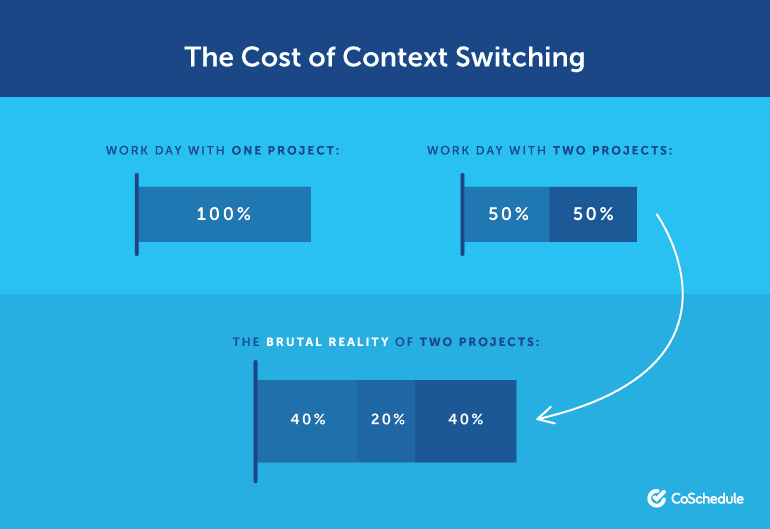
What About This Superpower?
As a marketer, there are myriad factors in beating constant context switching. But the single biggest productivity win you can make is getting organized. While there is a major downside to interruption and disorganization, there is only upside to focus and organization. As Herman points out in the video above, if you change the way you work, you can get dramatically different results. But not by working harder — simply by working more efficiently. While it’s not sexy, organization is actually the key superpower to defeat the impact of makeshift marketing, the cost of context switching, and the mental drain it creates. It’s mission critical because marketing today collaborates with nearly every facet of the business spectrum. We work with developers, designers, project managers, sales, customer support, and even our operations folks. Modern marketing becomes an untethered yarn ball if we don’t relentlessly organize our entire program. The path is simple, focus on just one thing: organization.
The path is simple, focus on just one thing: organization.
Why should organization be the one thing marketers focus on most?
Click To TweetThe Superpower Of Focusing On Just One Thing
One of my favorite books is The One Thing by Gary Keller, founder of the largest real-estate company in the world. He sums up the power of focusing on just thing nicely. “If everyone has the same number of hours in the day, why do some people seem to get so much more done than others? How do they do more, achieve more, earn more, have more? If time is the currency of achievement, then why are some able to cash in their allotment for more chips than others? The answer is they make getting to the heart of things the heart of their approach. They go small. Going small is ignoring all the things you could do and doing what you should do. It’s recognizing that not all things matter equally and finding the things that matter most. It’s a tighter way to connect what you do with what you want. It’s realizing that extraordinary results are directly determined by how narrow you can make your focus.” This works in every arena of life, too. Just ask author and leadership coach Peter Bregman, who attributes focusing on just one thing to losing 18 pounds in just over a month to designing better leadership programs for Fortune 100 companies. From your personal life to working at scale in a global organization, focusing on one impactful thing is the most successful driver of change. Here’s why organization should immediately become your one thing (and therefore transform into your superpower):- The average office employee spends over one hour each day just looking for things. Makeshift marketing is a primary driver of stats like this because of endless spreadsheets, single-function tools, and communication channels.
- Forbes ASAP reports that they typical executive wastes 150 hours per year searching for lost information. By having a single source of truth for your entire marketing program, you can gain weeks of time back… Not simply hours, but weeks!
- The Wall Street Journal showed that workers waste an average of 40% of our work days because of poor organizational skills. As illustrated before, context switching and makeshift marketing alone account for the majority of this time in a marketing context.
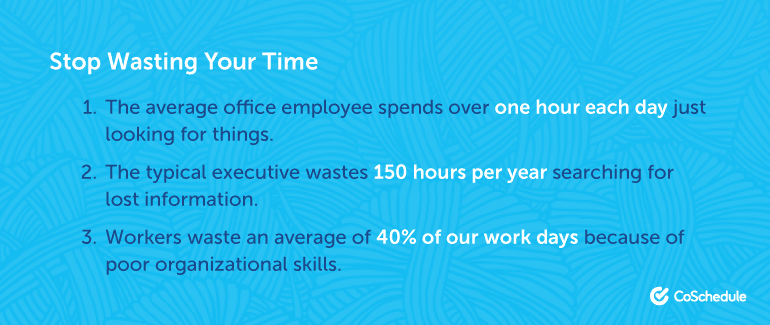 The truth is, you and your team can stop losing results to the mayhem of makeshift marketing today.
The truth is, you and your team can stop losing results to the mayhem of makeshift marketing today.
Here's how you and your team can stop losing results to the mayhem of makeshift marketing today.
Click To TweetWhere To Start Getting Organized
Step one is to assess your current state of organization, then ask counterbalancing questions. Answer three questions:- How many communication channels does our team use weekly? Include email, instant messaging, texting, threaded conversations in software tools, internal memos, etc.
- How many sources of information does my team reference or use weekly? Include reporting documents, spreadsheets, editorial calendars, processes, checklists, workflows, task lists, project roadmap, publishing schedule, etc.
- How many single-function tools does our team use weekly? Include project management tools, social scheduling software, calendar apps, instant messaging apps, shared password tool, etc.
- Is there a way to reduce communication channels?
- Is there a better method to organize our sources of information?
- Can we consolidate our marketing toolstack, removing redundant or ineffective apps?
Step One: Is there a way to reduce communication channels?
Using a Communications Matrix is a quick win for organizing the way your team collaborates. When I worked at an agency, unorganized communication was a harmful symptom of makeshift marketing. While working on the same project, my team would routinely talk via email, Google Talk (before it went away), Slack, drop bys, text messages, and even Facebook messenger. It’s not that any of us meant to be unorganized, but we were coordinating complex work from all over the place. As an account manager, I would be running from client meetings where new direction was decided upon, so I’d zip off a quick text message to my account coordinator because that’s the last place we had spoken. Then I’d send an email CC-ing our developers, designers, and their project manager notifying them that the wireframes are almost approved… But we have a few tweaks to make. Then I’d hop in my car and (before driving) would send a note to my boss, letting him know we would need to re-scope the project for some additional feature requests. Usually asking something like, “Should I bill them right now?” In the span of five minutes, I communicated with nearly ten people. And while that felt like effective communication, it actually caused systemic problems for me. Because now, I had three brand new layers of key info floating out in the ether. And I had to keep them organized in my head, while on the way to my next meeting, where I was about to do the same thing. A communications matrix is simple to outline, but takes discipline to implement. Simply sketch out a grid with two rows and two columns. It will visually organize the communication channels (or apps) your team will use internally and externally.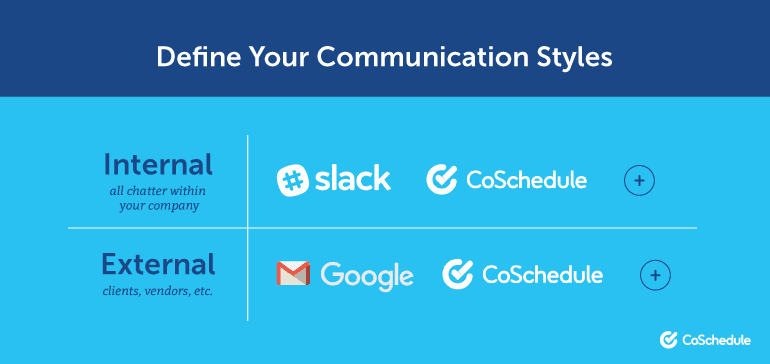 Now, yours may look totally different.
However, when my agency team did this, we reduced nine internal communication channels to just three. And six external channels down to two.
Now, yours may look totally different.
However, when my agency team did this, we reduced nine internal communication channels to just three. And six external channels down to two.
Step Two: Is there a better method to organize our sources of information?
Scattered information is a context-switching nightmare. You’re in total flow working on a project, productivity is at its peak. Then, you need to reference some data… a workflow… or other form of documentation… But drat, you keep forgetting to save the source as a bookmark in your web browser. Now you’re hunting for the info everywhere you can think of… Dropbox? Nope. Google Drive? Nada. Vortex? No. Now it’s time to dig through old email chains, looking for the last time you asked this question. But for reasons unknown to mankind, searching for an email in your Google-powered inbox absolutely sucks. So, you can’t find it. (Seriously, you can find anything on the internet in .23 seconds with a Google search. But you can’t find an email you sent last week?!) I have two great ideas for you cure this common ailment caused by the ugly villain makeshift marketing. First, if you reference social media analytics or team project performance, do yourself a favor and let CoSchedule do the hard work for you. With our advanced (and magically-automated) analytics you can see how everything is working at a glance.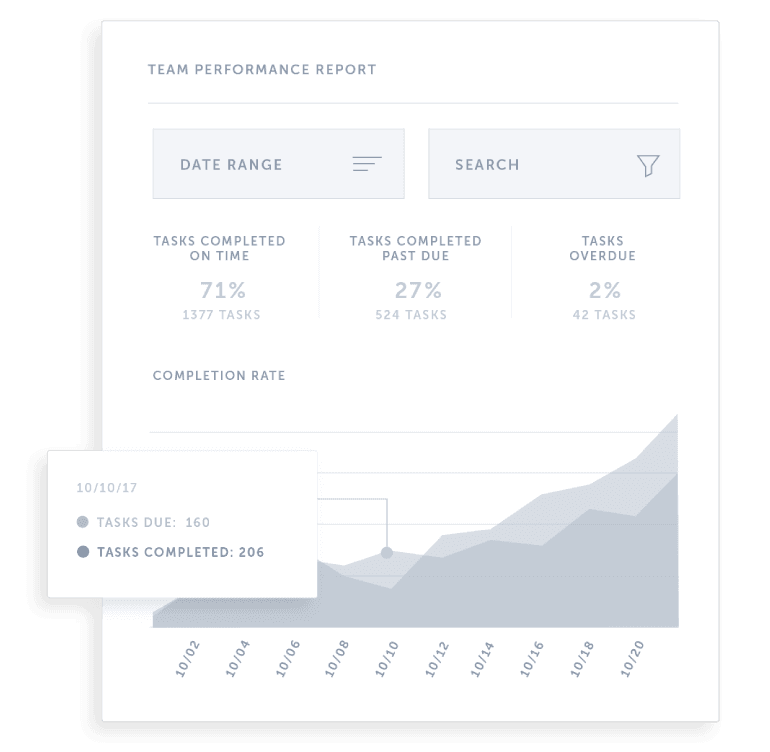 You can even schedule these reports to send as PDFs to the people who need to be in the know: whether internal stakeholders or clients.
Second, you can consolidate your information with a Master Resource Index.
I will admit, this is a Band Aid if ever there was one… After all, curing “too many spreadsheets” with another spreadsheet can turn into more poison than cure.
However, by creating a shared spreadsheet that absolutely everyone has access to, you can create a hyperlinked repository of all important information.
Like the communications matrix, this can be dead simple.
You can even schedule these reports to send as PDFs to the people who need to be in the know: whether internal stakeholders or clients.
Second, you can consolidate your information with a Master Resource Index.
I will admit, this is a Band Aid if ever there was one… After all, curing “too many spreadsheets” with another spreadsheet can turn into more poison than cure.
However, by creating a shared spreadsheet that absolutely everyone has access to, you can create a hyperlinked repository of all important information.
Like the communications matrix, this can be dead simple.
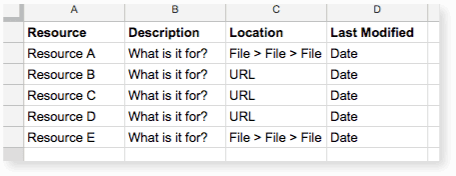
Step Three: Can we consolidate our marketing toolstack, removing redundant or ineffective apps?
With our toolstacks rapidly evolving — and growing. Often, it happens over time in a process of exchanging one tool for another. Only they have a habit of multiplying. It starts like this... You want get rid of some of those spreadsheets in favor of actual tools designed to solve specific problems. So, you get a social scheduling tool and quit using the social spreadsheet. Next comes a blog calendar tool, so you can quit using that spreadsheet. Then you get a task management tool to manage the email cadence and quit using that spreadsheet. Now you start using Google Calendar and quit using the events spreadsheet. And once you’re done… you need a spreadsheet just to unify the umpteen tools you started using to stop using spreadsheets because none of them communicate with one another. Not only this, your mishmash of paid and freemium tools don’t talk at all. Meaning a world of copy/paste marketing awaits. The best and only fix for this is your new secret weapon: CoSchedule. People often think of CoSchedule as a marketing calendar, but it is really best described as a total marketing management platform. The best way to think about it is as a mission control center for your marketing team.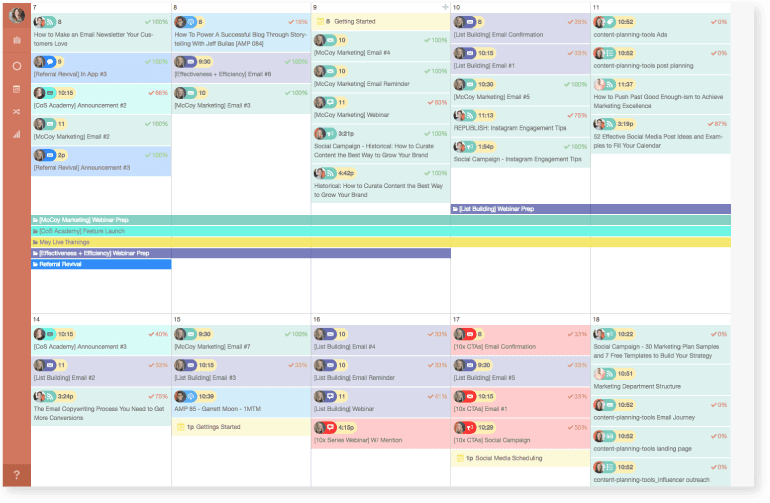 You’re looking at an organized, filtered view of our main campaigns. They’re color-coded by team ownership and content type.
They also give you quick access to analytics, show task completion rates, and contain ALL of the project communication and files in one place, so everyone stays on the same page.
CoSchedule is a marketing management platform that’s actually built specifically for marketers.
Every feature is made to organize and optimize your marketing program. So, you can stop losing productivity, efficiency, and results.
You’re looking at an organized, filtered view of our main campaigns. They’re color-coded by team ownership and content type.
They also give you quick access to analytics, show task completion rates, and contain ALL of the project communication and files in one place, so everyone stays on the same page.
CoSchedule is a marketing management platform that’s actually built specifically for marketers.
Every feature is made to organize and optimize your marketing program. So, you can stop losing productivity, efficiency, and results.
